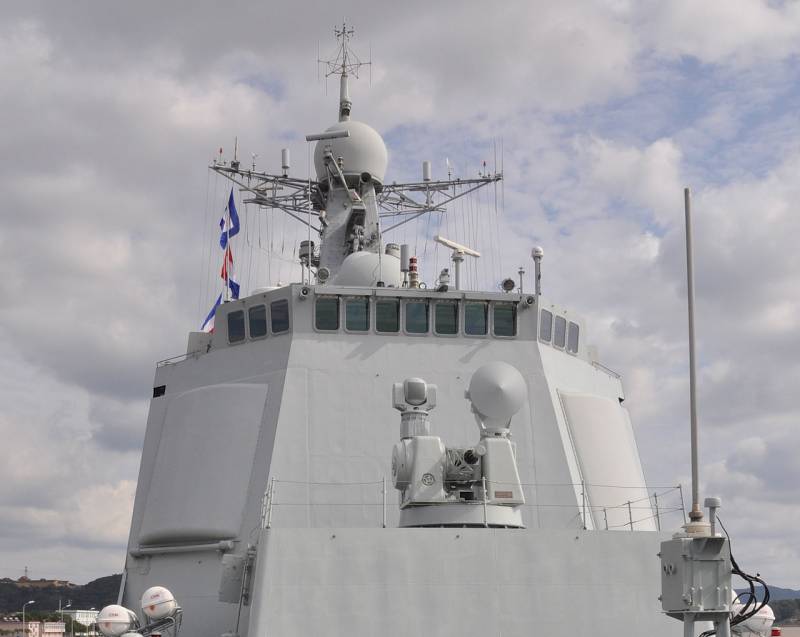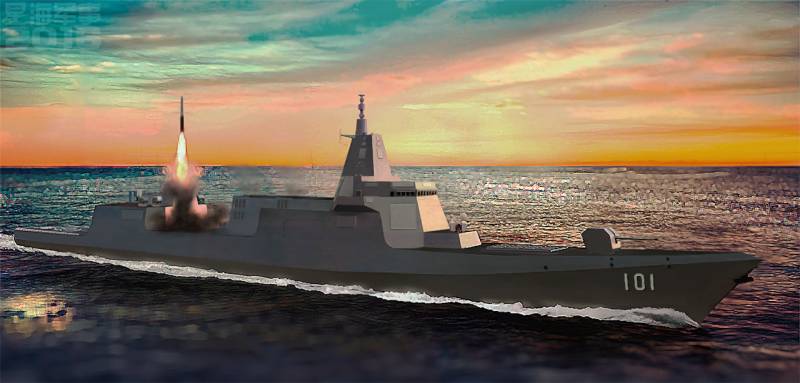China will put on ships over-the-horizon radar
In the last days of the first decade of January, Chinese media published materials on the latest developments in the field of science and technology. It was officially announced that Chinese scientists were able to create a radar station for over-the-horizon review, characterized by high performance, as well as having reduced dimensions. For the creation of such a project, the work manager received the highest award in China.
Professor Liu Yongtan, an employee of the information technology department of the Harbin Institute of Technology, spoke about the latest achievements of Chinese science in the field of radar. Liu Yongtang heads the program for the study and development of advanced radar systems and is responsible for the emergence of all new models, regardless of their class, type and purpose. Recently, the department of information technology has been involved in radar over-the-horizon detection. Outstanding results were obtained in this area, immediately recognized by the Chinese authorities.
For an outstanding contribution to the development of technologies and the creation of fundamentally new designs, Liu Yongtang 8 was awarded the presidential prize of the People's Republic of China in January. During the awards ceremony, the scientist spoke about his work and announced some information about their results. However, the winner of the presidential award did not go into details because of the general secrecy of the project and its importance.
According to the Chinese press, Liu Yongtan and his colleagues were engaged in the development and improvement of already known and proven technologies. It was a question of over-the-horizon radar stations. Such systems are designed to monitor the air and ground situation at large distances, outside the existing radio horizon. The principle of operation of such radars is based on the reflection of radio waves from the ionosphere and, in some cases, from the surface of the earth or water. Processing reflected and received using complex algorithms provides a search for various moving and stationary objects.
According to known data, China has several over-the-horizon radars involved in a missile attack warning system. These objects are large stationary structures and are located on land. Their task is to track dangerous directions and detect missile launches or other activities of a potential enemy. Over-the-horizon radar systems are of great importance for the security of China, however large sizes and power supply requirements impose certain restrictions and lead to risks.
In recent years, the Harbin Institute of Technology has been working on the development of over-the-horizon technology, and as a result has received very remarkable results. The results of the project were so important that its leader received the highest award of the country as the best scientist of the year. The essence of the work of Liu Yintana and his colleagues was to reduce the size of the radar station and reduce the requirements for its energy supply while obtaining the main characteristics at the required level.
As a result, a relatively small over-the-horizon radar project was created, capable of solving the tasks of searching and detecting various targets outside of the radio horizon. Unfortunately, the exact characteristics of such a product have not yet been reported. Liu Yongtan indicated only that such a product could be installed on a surface ship. Thus, the production and introduction of new radars will significantly increase the capabilities of the PLA naval forces in the context of surveillance, detection and target designation.
In an interview for South China Morning Star, Professor Liu described the main advantages of promising radars. So, using modern stations built on the basis of advanced technologies, the PLA Navy can monitor only 20% of its territorial waters. With the full implementation of new technologies, the coverage of these water areas will reach 100% with clear results for opportunities fleet.
It is expected that the shipborne over-the-horizon radar can be used not only to protect the coast, but also in the ocean zone. In this case, the ship connection will be able to monitor the environment in the enlarged area and learn about the threats earlier. Thus, the ships will have more time for the correct response to the actions of the enemy. In general, new location systems can become universal tools that provide problem solving in different conditions and situations.
Chinese experts and the media have not yet reported details of the future implementation of shipborne over-the-horizon radar. Moreover, it is not yet completely clear whether such a program will be implemented with an eye on practical application. If such plans exist, the command of the People’s Liberation Army of China is in no hurry to specify which ships and how soon they will receive new means of detection.
***
China traditionally does not publish all the details of its new projects, but the announced information about the new development of the Harbin Institute of Technology allows us to create a curious picture. We are talking about the completion of part of the work on a compact and not very demanding to power supply radar of a special kind. Such features in theory allow you to mount such equipment on surface ships of the main classes, providing them with new opportunities. In the future, the Chinese defense industry will be able to complete current work and provide the Navy with full-scale over-the-horizon radar stations.
According to known data, the most advanced of the Chinese shipborne radar is the 346 Type product. Depending on the height of the installation of an active phased antenna array, this station is able to monitor the surface and air conditions within a radius of 400-450 km - within the radio horizon. Due to the large size and weight, the “Type 346” can be installed only on large surface ships with a displacement of at least 7-8 thousand tons. So, its main carriers are destroyers of projects "Type 052D" and "Type 55".
What characteristics can show promising beyond-the-horizon radar for ships - is unknown. Apparently, its detection range will be at least 450-500 km; however, one cannot exclude the possibility of obtaining even higher characteristics, which accordingly expand the capabilities of the ship and the order as a whole.
It should be noted that shipborne over-the-horizon radars are not created only in China. Back in 2016, the American company Raytheon offered its version of such a product, which was then planned to offer to potential customers. The station from “Reyteon” meets the requirements and limitations of existing surface ships of American construction, but at the same time shows significant advantages over serial products of the “traditional” type.
In the volumes of existing ships and using affordable power supply, Raytheon engineers were able to create a radar with a detection range of up to 1000 km. Thus, one ship with such a radar will be able to monitor the situation in the zone of size 3,14 million square kilometers. For comparison, a country like India has a total area of slightly less than 3,3 million square kilometers. Three ships with a Raytheon radar will be able to cover the area equivalent to the territory of China.
It has not yet been reported what characteristics the Chinese engineers managed to get, but the nature of their development suggests that this is a station with an observation range exceeding the radio horizon. The advantages of such a system are obvious. A ship connection will be able to detect threats earlier and respond to them faster. Also, target designation will be simplified and the need for long-range radar surveillance aircraft will be reduced.
However, with all its advantages, a ship-based over-the-horizon radar station has several drawbacks. First of all, when developing such systems, there are problems associated with the dimensions of the equipment and its placement on the carrier. Achieving high technical characteristics is directly related to the size of the radar elements and power consumption. In this regard, there is a need for the simultaneous development of the station and the ship, and both projects must take into account each other’s features.
Due to the specificity of the operating principles, over-the-horizon radar cannot be the only means of detection on board a ship. Such a system will have to be supplemented with a “normal” station, capable of tracking targets up to the radio horizon. In addition, the necessary radar targeting and guidance weapons. All this makes new demands on the carrier.
***
It is known that over-the-horizon radars have been developed and are being developed in a number of leading countries of the world, and some of these developments are on alert, carrying out tracking of dangerous areas. In all cases we are talking about large stationary ground objects. In parallel with their operation, several countries are trying to develop compact and lightweight radars suitable for use, especially at sea. In this case, some success has already been achieved, but on the whole the situation so far does not look too optimistic.
A few years ago, American industry proposed its own version of the shipborne radar overseas review, but this project, as far as is known, has not yet come to practical implementation and introduction into service. Now it was announced the existence of a similar Chinese project. It is also in its early stages, and so far it cannot lead to the appearance of full-scale samples of electronic equipment suitable for installation on ships.
According to available data, the specialists of the United States and China are continuing various work on the creation of advanced ship systems, and in the foreseeable future can present ready-made results. At the same time, the real prospects of the proposed radar are not completely clear. So, the Pentagon was interested in the project of the company "Raytheon", but the construction of ships with such stations is still out of the question. Information about the interest of the military to the Chinese project is not yet available. It is possible that the installation of over-the-horizon radar on Chinese ships will be known only after the start of their service.
To date, Chinese scientists and engineers have managed to carry out part of the necessary research work and get the desired results. For the work done, the project manager received the highest prize of the People's Republic of China. It is argued that work on the project will continue, and in the future will lead to a sharp increase in some of the capabilities of the PLA Navy. However, the exact parameters of the new equipment and the timing of its deployment are still unknown. Anyway, China is doing everything possible to develop its military fleet, which protects the coast of the country and plans to gain a foothold in the ocean zone.
On the materials of the sites:
https://scmp.com/
https://timesnownews.com/
https://timesofindia.indiatimes.com/
https://news.com.au/
https://vnexpress.net/


Information